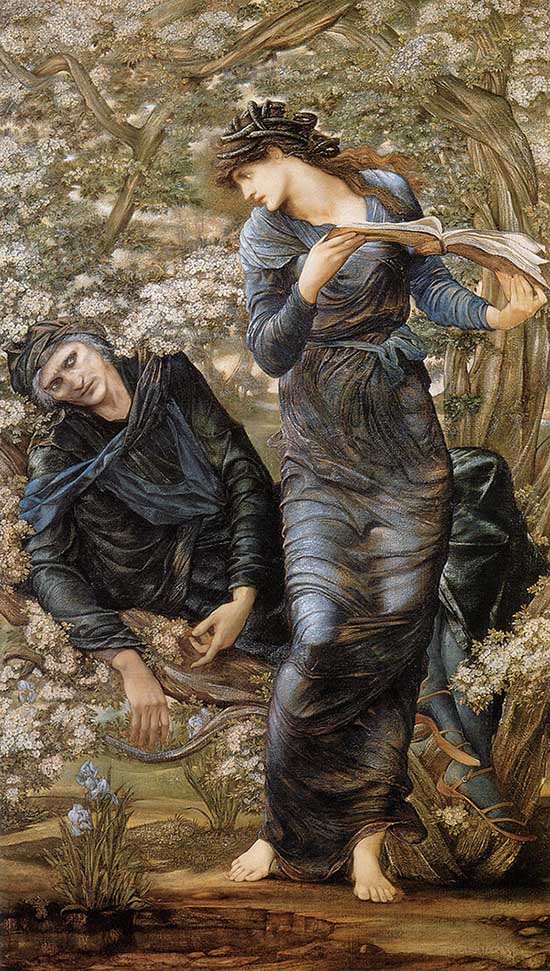Nimiane, Nineve, Nymue
At Arthur’s marriage feast, Merlin bade the knights sit still around the Table, telling them they would soon see a strange and marvelous adventure. As they sat, in ran a white hart, chased by a white brachet, with thirty couple of black hounds running after. The brachet bit the hart, which then leaped and knocked over a knight. This knight got up, caught the brachet, and left the hall to mount his horse and ride away. Immediately in rode a lady on a white palfrey and
cried aloud to King Arthur, Sir, suffer me not to have this despite, for the brachet was mine ... [W]ith this there came a knight riding all armed on a great horse, and took the lady away with him with force, and ever she cried and made great dole. When she was gone the king was glad, for she made such a noise.
But Merlin insisted that the adventures could not be dismissed so lightly. So, on the mage’s advice, Gawaine was sent after the white hart, the newly knighted Sir Tor after the knight who had stolen the brachet, and King Pellinore after the knight who had stolen the damsel. Tor came through the adventures with the most honor, for Gawaine had the mischance to slay a lady while aiming for her lord, Sir Ablamar of the Marsh, while Pellinore was so hot in his quest that he did not try to stop to help a lady with a wounded knight – only learning when he came back and found them dead that she had been his own daughter Eleine.
Pellinore succeeded in the quest itself, however; he found and slew the abductor, Sir Hontzlake of Wentland, made the acquaintance of the damsel’s cousin, Sir Meliot of Logurs, and his sworn brother Sir Brian of the Isles, and brought the damsel back to court. This damsel of the white brachet was Nimue.

Merlin now became besotted with Nimue, taught her magic, and took her with him on a visit to Benwick. She might already have been one of the minor damsels of the Lake; now, perhaps through Merlin’s influence, she became the chief Lady of the Lake in place of the one Balin had slain.
Troubled by Merlin’s lecherous intentions, however, and “afeard of him because he was a devil’s son”, Nimue at last used the crafts he had taught her to imprison him under a great stone. (Other early versions, however, show her as putting him in comfortable retirement through genuine affection, perhaps sisterly, for him.)
Perhaps, having retired Merlin for whatever reason, Nimue felt obligated to take Arthur under her wing in Merlin’s stead. Whereas Merlin’s style seems to have been hovering around the court keeping more or less underfoot, Nimue apparently spent most of her time in her Lake, appearing only at need. For instance, she arrived just in time to foil Morgan’s crafts and help Arthur win the fight against Sir Accolon, then quietly left again. She appeared in the Forest Perilous just in time to enlist Sir Tristram’s aid and save Arthur from the sorceress Annowre.
Sometimes she did not arrive as early as she might have, as in the affair of the poisoned apples; but neither Merlin always been on time, and his tardiness had sometimes resulted in unnecessary deaths. At any rate, despite Arthur’s annoyance with Nimue’s noise at their first meeting,
ever she did great goodness unto King Arthur and to all his knights through her sorcery and enchantments.
Despite her former opposition to Morgan, Nimue accompanied Morgan, the Queen of Norgales, and the Queen of the Waste Lands when they came in their ship to bear away the mortally wounded Arthur.
Nimue found Sir Pelleas when he was bemoaning Gawaine’s betrayal of him in the matter of Dame Ettard. Falling in love with Pelleas herself, Nimue caused him to love her instead of Ettard, and Ettard to love him as hopelessly as he had originally loved her. Although she brought him to Arthur’s court and may well have sponsored him when he was made a companion of the Round Table, after their marriage Nimue kept Pelleas safe from harm, persumably even in the final battles between Arthur and Mordred. (Her union with Pelleas could be reconciled with the “loving retirement” theory of what she did to Merlin. Cf. Thomas Wentworth Higginson, Tales of Atlantis and the Enchanted Isles.)
See also
Nineve | The Legend of King Arthur
Guenevere: The Poisoned Apple | The Legend of King Arthur
Source
Le Morte Darthur | Sir Thomas Malory, 1469-1470
